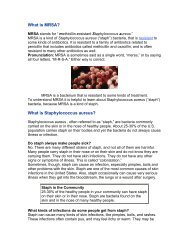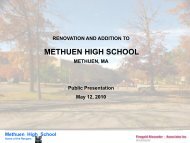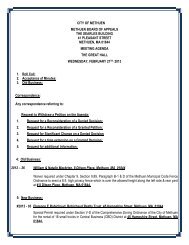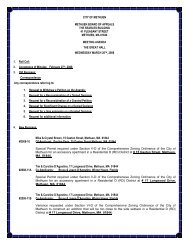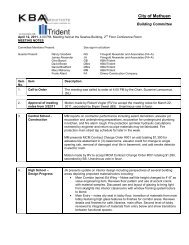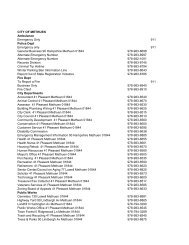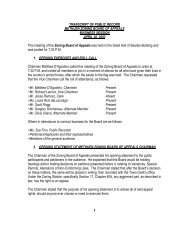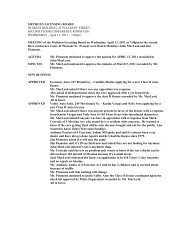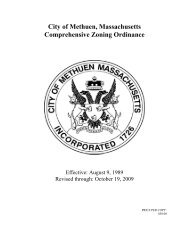City of Methuen Master Plan
City of Methuen Master Plan
City of Methuen Master Plan
You also want an ePaper? Increase the reach of your titles
YUMPU automatically turns print PDFs into web optimized ePapers that Google loves.
<strong>Methuen</strong> <strong>Master</strong> <strong>Plan</strong> 2007<br />
methods as outlined in the Smart Growth Toolkit as provided by the State <strong>of</strong> Massachusetts. As stated<br />
in the Toolkit, Low Impact Development is a more sustainable land development pattern that results<br />
from a site planning process that first identifies critical natural resources, then determines appropriate<br />
building envelopes. LID also incorporates a range <strong>of</strong> best management practices (BMPs) that preserve<br />
the natural hydrology <strong>of</strong> the land.<br />
SUMMARY OF NATURAL RESOURCE FINDINGS<br />
<strong>Methuen</strong> has a rich natural heritage worthy <strong>of</strong> recognition and pride. The following is a summary <strong>of</strong><br />
some <strong>of</strong> the most important considerations for the development <strong>of</strong> the master plan.<br />
Soil limitations, especially slope mean that many areas are poorly suited for development. Wetlands,<br />
streams, ponds and water supplies need to be carefully monitored to prevent contamination from<br />
contaminants.<br />
<strong>Methuen</strong> still has some important agricultural areas that have not been developed and are in need <strong>of</strong><br />
protection if the city wishes to preserve some <strong>of</strong> its agricultural heritage. These scattered agricultural<br />
areas are both important to wildlife and provide part <strong>of</strong> the distinctive character <strong>of</strong> the city.<br />
Several <strong>of</strong> the city’s ponds and streams <strong>of</strong>fer good fishing and serve as wildlife corridors. Access to<br />
these resources needs to be protected and in some cases improved.<br />
The protection <strong>of</strong> upland forests will help preserve some <strong>of</strong> the city’s character. Much <strong>of</strong> <strong>Methuen</strong>’s<br />
wildlife diversity is a result <strong>of</strong> its variety <strong>of</strong> habitat types. Maintenance <strong>of</strong> that diversity requires<br />
protection <strong>of</strong> both small and large areas <strong>of</strong> different habitats; non-forested wetlands, forested uplands,<br />
open/vacant areas, and open space corridors that make connections between areas.<br />
One vital aspect <strong>of</strong> retaining the city’s semi-rural quality lies in retaining some <strong>of</strong> the visual impact <strong>of</strong> the<br />
city’s forested land. Forests on hills are particularly desirable, since such land is both highly visible and<br />
highly vulnerable to development pressures and its concomitant erosion and run<strong>of</strong>f problems.<br />
<strong>Methuen</strong>’s steep slopes and changes in topography contribute to the importance <strong>of</strong> these hills.<br />
OPEN SPACE AND RECREATION<br />
<strong>Methuen</strong> completed an update <strong>of</strong> its Open Space and Recreation <strong>Plan</strong> in May 2001. The plan is briefly<br />
summarized below. A section on implications for the master plan will follow this summary <strong>of</strong> the open<br />
space plan.<br />
Open Space and Recreation <strong>Plan</strong> – 2000-2005 Update<br />
General Features<br />
The <strong>Methuen</strong> Open Space and Recreation <strong>Plan</strong> (Open Space <strong>Plan</strong>) was developed by an Open Space<br />
and Recreation <strong>Plan</strong>ning Committee with the participation <strong>of</strong> Community Development Department,<br />
the Conservation Commission, the Historic District Commission, the Merrimack Valley <strong>Plan</strong>ning<br />
Commission, the Recreation Department, the Forest Lake Association, the <strong>City</strong> Council, the mayor, and<br />
two representatives <strong>of</strong> concerned citizens. Protection <strong>of</strong> open space and historic resources was clearly<br />
viewed as an important means to maintain some <strong>of</strong> the character <strong>of</strong> the city’s past.<br />
The Open Space <strong>Plan</strong> reflects the residents’ strong desire for protecting natural resources as a means <strong>of</strong><br />
preserving some <strong>of</strong> the communities most recognizable open space assets, like wetlands, water bodies,<br />
forested areas, and meadows as wildlife habitats and areas for passive recreation and environmental<br />
Page 132



